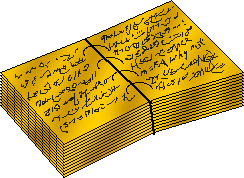Commandeur Adama
Magister Ordo Kolob - Admin

Nombre de messages : 8905
Age : 60
Localisation : Pays de Néphi - Mormon forest
Date d'inscription : 16/02/2007
Chevalier de Kolob - Vers la Sagesse
 A reçu la Lumière: 180 A reçu la Lumière: 180
 En quête du Vase Précieux et Elu: En quête du Vase Précieux et Elu:
    (150/200) (150/200)
 A la recherche du couple de Licornes du Jardin d'Eden: A la recherche du couple de Licornes du Jardin d'Eden:
    (7/700) (7/700)
 |  Sujet: Directions in Hebrew, Egyptian and Nephite Language Sujet: Directions in Hebrew, Egyptian and Nephite Language  Sam 14 Juin - 0:02 Sam 14 Juin - 0:02 | |
|  Directions in Hebrew, Egyptian and Nephite Language Directions in Hebrew, Egyptian and Nephite Language
Based on research by William J. Hamblin A great deal of effort has gone into trying to correlate the cities and regions mentioned in the Book of Mormon with the geography of the Americas. The most widely accepted attempt currently is the "limited geography" theory most extensively developed by John Sorenson.1 Some critics have claimed that Sorenson's theory is incorrect because the lands he ascribes to the Book of Mormon are actually situated along a northwest/southeast axis rather than north/south as described in the Book of Mormon. Sorenson offers an excellent discussion of this issue,2 to which the following can be added. How would the Nephites, using the "learning of the Jews and the language of the Egyptians" (1 Nephi 1:2), have written north, south, east, and west? The Hebrews, like most Semitic peoples, oriented themselves by facing east, toward the rising sun. Thus east in Hebrew was simply front, with south as right, north as left, and west as rear or "sea".3 But the Nephites also knew the "language of the Egyptians" (1 Nephi 1:2; Mosiah 1:4; Mormon 9:32). The Egyptians oriented themselves by facing south, toward the source of the Nile. "One of the terms for 'south' [in Egyptian] is also a term for 'face'; the usual word for 'north' is probably related to a word which means the 'back of the head.'" The word for east is the same as for left, and west is the same word as right.4Thus the Hebrew orientation is shifted 90 degrees from the Egyptian. The Hebrew word for west (rear) has the same basic meaning as Egyptian north (back of the head); Hebrew east (front) equals Egyptian south (face); Hebrew north (left) matches Egyptian east (left); with Hebrew south (right) being Egyptian west (right). Thus when Nephi or his descendants wrote "in the language of the Egyptians," they would conceptualize the land westward in terms of the Hebrew word back. But in writing the Hebrew land backward in Egyptian characters, they would actually be writing the Egyptian word for land northward. So when the Nephites wrote the Egyptian word for north, did they have the Hebrew meaning west in mind, or the Egyptian meaning north? If Nephi used the Egyptian terms with Hebrew meanings in mind, and if Joseph Smith then translated those terms literally, a remarkable coincidence occurs. In the Hebrew (and modern) concept of directions, land westward (Hebrew rear) would have been written in Egypto-Nephite characters as land northward (Egyptian behind ), and land eastward (Hebrew front) would have been written in Egypto-Nephite as land southward (Egyptian front). In other words, the conceptual geography of the Hebrew universe must be "distorted" in relation to the Egyptian vocabulary in precisely the way that Nephite geography seems "distorted" in relation to Mesoamerica. Such Nephite behavior would parallel the way the Egyptians dealt with the problem of fitting their conceptual scheme to strange landscapes encountered when they traveled outside Egypt. They did not change their world view to fit the new geographical facts but simply kept the same terminology. This is shown in their handling of the direction of flow of the Euphrates River. As we have seen, "The Egyptian word 'to go north,' is also the Egyptian word 'to go downstream,' and the word 'to go south' is also the word 'to go upstream,' against the current [of the Nile]. When the Egyptians met another river, the Euphrates, for example, that flowed south instead of north, they had to express the contrast by calling it 'that circling water which goes downstream in going upstream,'" which could also be translated as "the river which flows 'north' [Egyptian downstream] by flowing 'south' [Mesopotamian downstream]."5 In other words, they kept their own cosmographic mindset unchanged while they adjusted the "real-world" geography to fit it--which seems to be what the Nephites did. If this way of translating directions did not bother the Egyptians, it may not have bothered their contemporaries, the Nephites. Thus we can see that cardinal directions were not expressed by ancient civilizations in the same way they are by modern civilizations. We need to consider how the Nephites in fact labeled their geography, rather than simply to presume that north must mean the direction north as we now understand it. Notes
1. John L. Sorenson, An Ancient American Setting for the Book of Mormon (Salt Lake City: Deseret Book and FARMS, 1985).2. Ibid., 38-42.3. See Brevard S. Childs, "Orientation," in George Buttrick, ed. The Interpreter's Dictionary of the Bible (New York: Abingdon Press, 1962), 3:608.4. John A. Wilson, in Henri Frankfort, et al., Before Philosophy: The Intellectual Adventure of Ancient Man (Baltimore: Penguin Books, 1972), 51.5. Ibid., 45-46. Reference : http://www.meridianmagazine.com/farms/011126language.html | |
|

